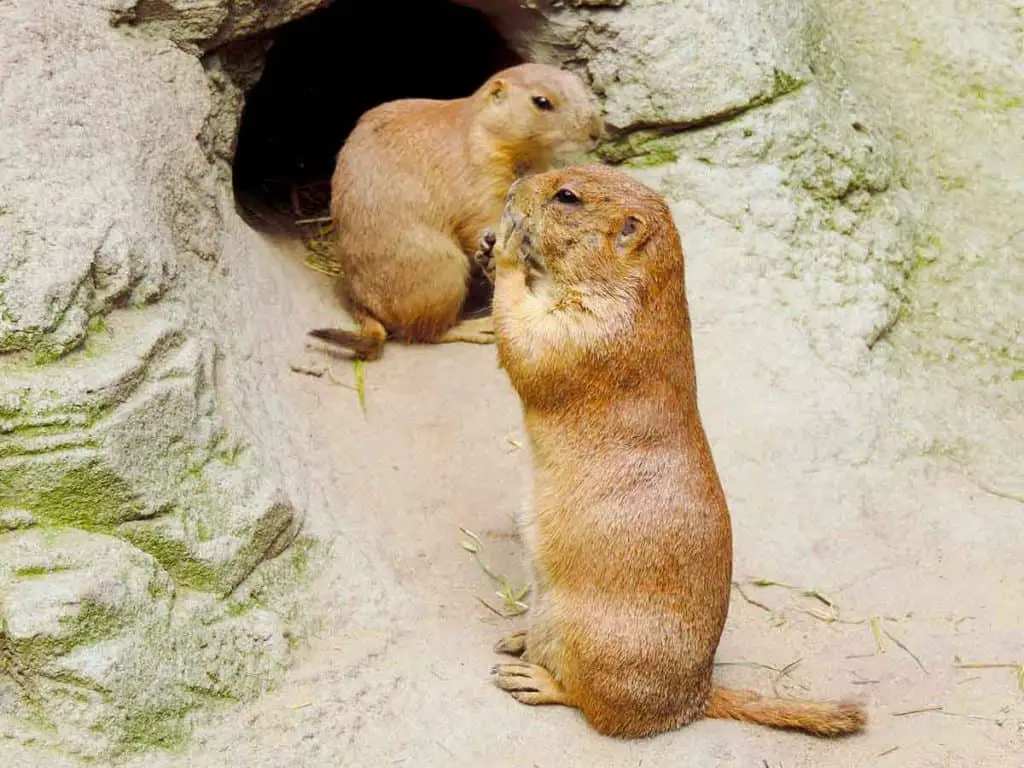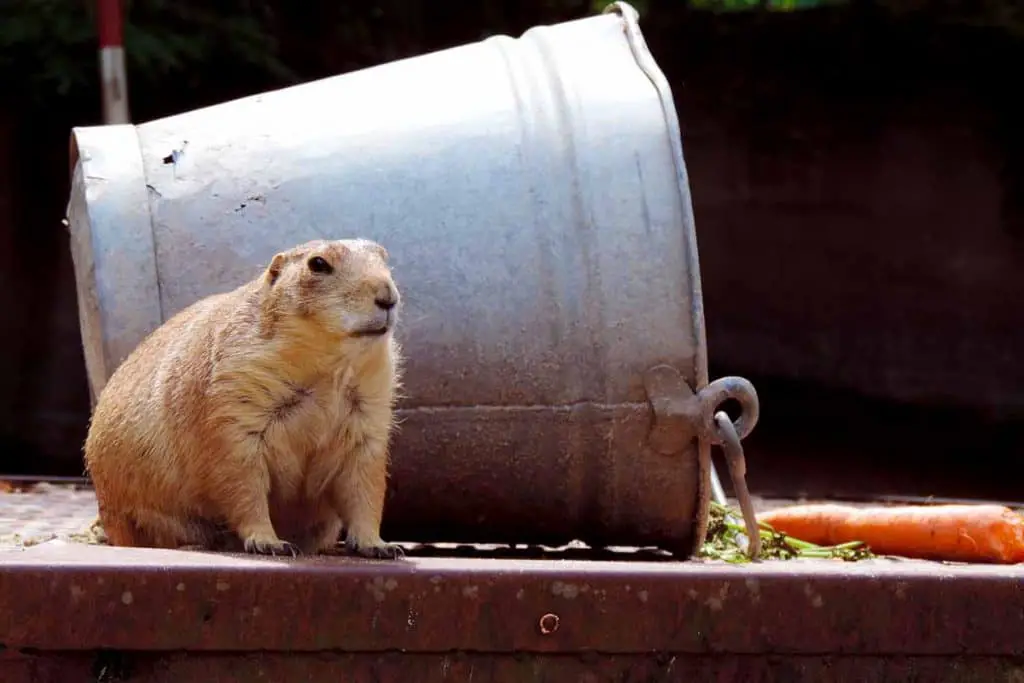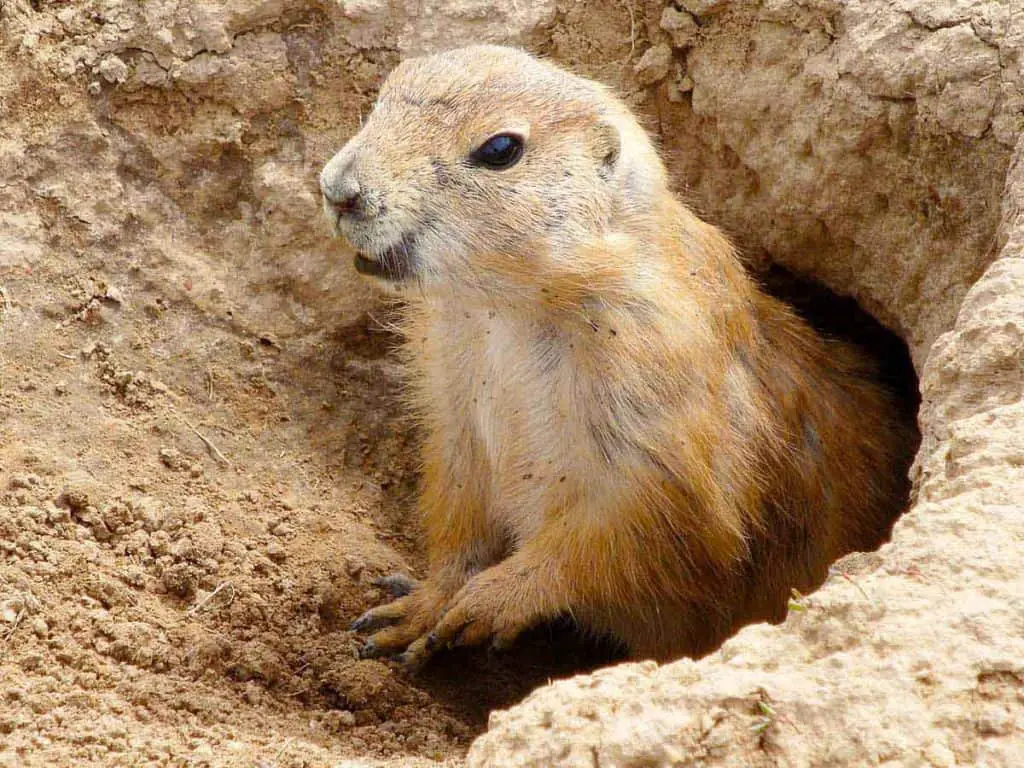Get Rid of Groundhogs (10 Sure-Fire Ways)
Animal lovers describe groundhogs as cute, but you label them a pest.
You have groundhogs around your home, wreaking havoc, and you simply want them to perish!

Groundhog Quick Facts
Some quick info about groundhogs before we proceed to get rid of them:
Groundhogs are also called woodchucks or marmots. They are a rodent closely related to squirrels, and some people refer to them as giant ground squirrels.
The size difference between groundhog and squirrel?
Squirrels typically measure 12” to 18” in length, inclusive of the tail, but groundhogs can grow up to 24” with a considerably heavier build.
With their 18 chewing teeth and 4 chisel-shaped incisors, you know the extensive damage they could inflict on your favorite plants or small pets. When you notice their presence on your property, you need to take action fast.
Before addressing methods to get rid of groundhogs, it is crucial to understand what attracts them in the first place and where they usually build their home within yours.

What Attracts Groundhogs?
Much like beavers, groundhogs have rapidly growing incisor teeth at the front of their mouth, and they must constantly chew and gnaw to keep those incisors’ growth in check.
The groundhogs’ gnawing tendency and climbing ability make any food or chewable object around your house an attractive target:
- Fruits on the ground or in the trees.
- Most vegetables.
- Plants.
- Unsecured garbage cans.
Where Do They Burrow?
Groundhogs need to burrow underground to live and:
- Protect from predators,
- Hibernate, and
- Breed.
The burrows groundhogs make typically consist of one entrance with multiple internal chambers and exits and a network that runs longer than 10 feet.
They can be new or existing burrows left vacant by other similarly-sized rodents, which means you do not necessarily need to spot groundhogs before plugging those holes. Prevention keeps you a step ahead of them.
Keep a lookout for these places where groundhogs typically burrow:
- Open ground that backs up against woody vegetation.
- Under the house, porch, or outbuilding.
- Near trees, walls, or fences.

THE 10 WAYS TO GET RID OF GROUNDHOGS
Use what the groundhogs hate against them and remove favorable conditions for their burrows, and you make your house a less desirable property for them to make a home.
Get rid of groundhogs or woodchucks effectively with these methods:
- Crush fresh garlic and drop them into the groundhog’s burrow daily.
- Sprinkle ground pepper around and into the hole.
- Spray off-the-shelf fox or coyote urine around the burrow or areas such as the vegetable garden or fruit tree to repel groundhogs. They fear these predators’ scents. But beware of the diluted products on the market.
- Sprinkle blood meal around and in your vegetable garden. It repels the groundhogs but fertilizes the soil.
- Build a steel wire fence with 3-foot tall posts around the fruit or vegetable garden: 1-foot wire into the ground to prevent tunneling and 4-foot wire above ground with the top foot bent outwards to prevent climbing over.
- Clear away woodpiles, clutter, and weed in the yard to make it less desirable for the groundhogs (but this may not be effective prevention).
- Soak a rag with ammonia, place it at the burrow’s entrance; pour the excess ammonia solution into the hole.
- Pour used kitty litter into the burrow’s hole, or simply flood the burrow with any foul-smelling liquid you desire.
- Use a trap-and-relocate method if you want to get rid of groundhogs without harming them.
- Shoot them.
You choose and combine the methods to suit your groundhog problem.
What Do Groundhog Hate?
The methods to get rid of groundhogs without killing them involve mostly using a substance that is offensive to the animal.
You may already have the solutions in your home, so your efforts to get groundhogs out of your property can begin immediately.
These substances can help to get rid of groundhogs:
- Crushed garlic.
- Ammonia.
- Vinegar (combined with soapy water).
- Bleach.
- Agricultural lime.
- Smoke bombs.
- Mothballs (less effective).

When Are They Most Active?
A groundhog’s life follows the changing seasons to suit their biological needs.
Their habitat stretches from the central United States to northern Canada, and groundhog hibernation season starts from late fall to the end of winter.
After emerging from their winter hibernation, groundhogs are most active during the day, beginning late winter; the males would seek out potential females to mate. This active period stretches through the spring, summer, and fall seasons.

Best Way to Trap Groundhogs
The rules regarding trapping and relocating pest animals vary between states and municipalities. It is best to check before you proceed to get rid of the groundhogs on your property.
Best Trap Bait
Most foods make attractive baits, as long as you leave them accessible to the groundhogs and near or along their path.
The best baits for trapping groundhogs or woodchucks include:
- Fruits such as cantaloupe, berries, and apple.
- Vegetables such as lettuce, carrot, and corn.
- Cat food.
Ideal Live Trap Size
Groundhogs are one of the largest rodents, and you use appropriately-sized cages to trap them safely and humanely before relocation.
The best-sized live trap for groundhogs or woodchucks should measure at least 12” x 12” at the trap door and 30” trap depth so that the animal can safely fit in the cage before triggering the door to shut. Any trap of larger dimensions is preferable.
Best Live Trap for Groundhogs:
Duke Heavy Duty X-Large Trap

Any regular-sized rodent trap on the market will not suffice for a groundhog that can grow up to 24” in total length. The groundhog’s size and weight give it enough strength to force its way out of a weakly-constructed cage.
The Duke trap is heavy-duty and the right size to successfully and safely trap a groundhog.
Handle the cage with a trapped groundhog cautiously. When releasing the groundhog, put a thick cloth over the cage before opening the door to prevent injury from the animal clawing or biting.
What you get with this live trap:
- Extra-large L36 x H14 x W15 inches.
- Excellent size trap for large rodents.
- Sturdy construction makes trapping safer for the animal.
- A small door on the trap’s roof for baiting.

Where to Relocate Them?
If groundhog relocation is permissible in your jurisdiction, a meadow or woodland at least 5 to 10 miles away from your home is best. Do not release them near residential areas as you are merely making the groundhog somebody else’s problem.
Best Way to Kill Groundhogs
Many homeowners will think of using a kill trap if killing the groundhog is an option.
Kill traps for rodents typically involve snapping or crushing their neck and head, and for a large rodent, the resulting mess is undesirable. Further, a kill trap large enough to kill the groundhog will essentially also be a danger to you and your pet.
Unfortunately, when groundhogs pose severe risks to your property, and you exhausted other alternatives, shooting may be the best way to kill them.
What Damage Can Groundhogs Do?
With their four large incisor teeth, groundhogs can cause considerable damage to you and your pet and property:
- A cat’s size is comparable to a groundhog’s, so the groundhog will attack the cat if it feels threatened.
- Smaller pet dogs are also at risk of getting bitten by groundhogs. On the contrary, large dogs are a threat to the groundhogs.
- Groundhogs are a nuisance to humans as they destroy vegetable gardens, flower beds, and farms.
- Accidental stepping into a burrow’s hole can break the foot.
- The groundhog’s burrowing activities under the house may destabilize your house’s foundation and undermine its structural integrity. They may also chew through electrical wires and water pipes, leading to costly repair work.
